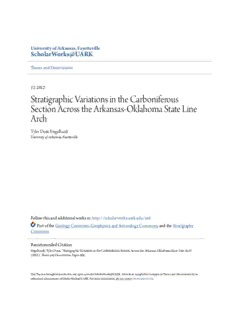
Stratigraphic Variations in the Carboniferous Section Across the Arkansas-Oklahoma State Line Arch PDF
Preview Stratigraphic Variations in the Carboniferous Section Across the Arkansas-Oklahoma State Line Arch
UUnniivveerrssiittyy ooff AArrkkaannssaass,, FFaayyeetttteevviillllee SScchhoollaarrWWoorrkkss@@UUAARRKK Graduate Theses and Dissertations 12-2012 SSttrraattiiggrraapphhiicc VVaarriiaattiioonnss iinn tthhee CCaarrbboonniiffeerroouuss SSeeccttiioonn AAccrroossss tthhee AArrkkaannssaass--OOkkllaahhoommaa SSttaattee LLiinnee AArrcchh Tyler Dean Engelhardt University of Arkansas, Fayetteville Follow this and additional works at: https://scholarworks.uark.edu/etd Part of the Geology Commons, Geophysics and Seismology Commons, and the Stratigraphy Commons CCiittaattiioonn Engelhardt, T. D. (2012). Stratigraphic Variations in the Carboniferous Section Across the Arkansas- Oklahoma State Line Arch. Graduate Theses and Dissertations Retrieved from https://scholarworks.uark.edu/etd/606 This Thesis is brought to you for free and open access by ScholarWorks@UARK. It has been accepted for inclusion in Graduate Theses and Dissertations by an authorized administrator of ScholarWorks@UARK. For more information, please contact [email protected]. STRATIGRAPHIC VARIATIONS IN THE CARBONIFEROUS SECTION ACROSS THE ARKANSAS-OKLAHOMA STATE LINE ARCH STRATIGRAPHIC VARIATIONS IN THE CARBONIFEROUS SECTION ACROSS THE ARKANSAS-OKLAHOMA STATE LINE ARCH A thesis submitted in partial fulfillment of the requirements for the degree of Master of Science in Geology By Tyler D. Engelhardt University of Northern Iowa, Bachelor of Arts in Geology, 2008 December 2012 University of Arkansas ABSTRACT The State Line Arch is represented by a structural high that trends through the study area in a loose alignment with the Arkansas-Oklahoma state line. Evidence of the arch extending further to the north includes a structural high and stratigraphic variation at an outcrop on Highway 59 near Evansville Mountain in Crawford County, Arkansas. The exact timing of the formation of the arch remains undetermined, but upper Devonian thinning at the top of the arch indicates the structure is pre-Mississippian. The reason for the development of the arch is poorly understood, but evidence linking Mississippian-aged Waulsortian mounds to Precambrian Spavinaw granite structures of northeastern Oklahoma and southwestern Missouri suggests Precambrian basement structures may extend into the study area. The structural nature of the arch provided an environment favorable to carbonate build-up during deposition of the Mississippian interval. A previously unidentified limestone unit measuring 175 feet thick likely represents the transgressive phase of a transgressive-regressive sequence responsible for the deposition of the Mayes Group of northeastern Oklahoma. Growth on the downthrown side of the Muldrow-Mulberry Fault system may indicate earlier movement than previous studies have suggested on the east-west trending normal faults of the Arkoma Basin. A possible roll-over anticline structure may exist to the south of the Muldrow-Mulberry fault system. This thesis is approved for recommendation to the Graduate Council. Thesis Director: Dr. Doy L. Zachry Thesis Committee: Dr. Walter L. Manger Mr. Douglas C. Melton, Jr. THESIS DUPLICATION RELEASE I hereby authorize the University of Arkansas Libraries to duplicate this thesis when needed for research and/or scholarship. Agreed __________________________________________ Tyler D. Engelhardt Refused __________________________________________ Tyler D. Engelhardt ACKNOWLEDGEMENTS I would like to thank each of my thesis committee members for all of their work in helping me complete this investigation. My thesis advisor, Dr. Doy Zachry, despite teaching such a heavy load of classes during the school year and field camp during the summer, has always done his best to be available to help with whatever I have needed. Dr. Walter Manger, although “retired” while this work was in progress, has always been eager to offer his expertise. Also, thank you to Mr. Doug Melton of Southwestern Energy, who frequently visited Fayetteville to check my progress and answer questions. Aside from serving as scholastic mentors in the completion of this Master’s thesis, the three men named above have also been able to contribute to me their wisdom through casual conversation. Not only has this helped to ease the strain associated with writing a thesis, but it has also helped to shape my mind in way that will benefit me greatly in future professional endeavors. I would also like to thank Southwestern Energy for the financial support along with the initiation of this thesis topic and the use of associated data. For the faculty and students at the University of Arkansas Department of Geosciences, thanks for helping to make my two years in Fayetteville rank among the best of my life. I will never forget the many friends I made at the University of Arkansas, or the countless memorable experiences and endless laughter I was able to share with them. TABLE OF CONTENTS Introduction ................................................................................................................................1 Background .............................................................................................................................2 Purpose of Study .....................................................................................................................5 Log Analysis ...............................................................................................................................8 Geologic Setting........................................................................................................................ 11 Basement Features ................................................................................................................. 12 Ozark Dome .......................................................................................................................... 15 Ouachita Associated Tectonics .............................................................................................. 16 Arkoma Basin ........................................................................................................................ 18 Ouachita Mountains ............................................................................................................... 20 Lithostratigraphy ....................................................................................................................... 22 Lower Mississippian .............................................................................................................. 22 Upper Mississippian .............................................................................................................. 26 Pennsylvanian- Morrowan ..................................................................................................... 27 Pennsylvanian- Atokan .......................................................................................................... 29 Depositional History ................................................................................................................. 30 Lower Mississippian .............................................................................................................. 30 Upper Mississippian .............................................................................................................. 33 Pennsylvanian Morrowan ...................................................................................................... 35 Pennsylvanian lower Atokan ................................................................................................. 40 Discussion ................................................................................................................................. 41 Devonian ............................................................................................................................... 41 Lower Mississippian .............................................................................................................. 44 Upper Mississippian .............................................................................................................. 51 Pennsylvanian Morrowan ...................................................................................................... 54 Pennsylvanian lower Atokan ................................................................................................. 56 Cross Sections ........................................................................................................................... 58 Conclusions .............................................................................................................................. 67 References ................................................................................................................................ 68 Appendices ............................................................................................................................... 73
Description: